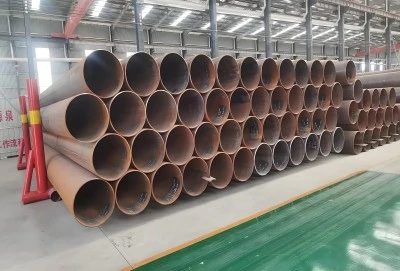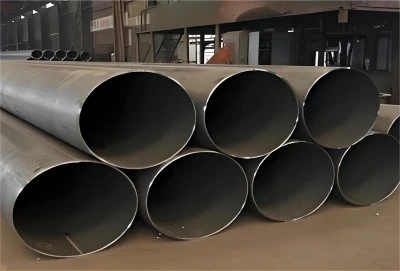In the world of pipeline construction and oil and gas transportation, choosing the right pipe grade is crucial for ensuring safety, efficiency, and longevity. Two popular grades that often come up in discussions are API 5L X60 and X65 pipes. While they may seem similar at first glance, there are significant differences between these two grades that can impact their performance and suitability for various applications. In this comprehensive guide, we'll explore the key distinctions between X60 pipes and X65 pipes, helping you make an informed decision for your next project.
|
|
|
How do the chemical compositions of X60 and X65 pipes differ?
The chemical composition of a pipe plays a crucial role in determining its strength, durability, and overall performance. When comparing X60 and X65 pipes, we can observe some notable differences in their chemical makeup:
1.Carbon Content
One of the primary distinctions between X60 and X65 pipes lies in their carbon content. X65 pipes typically have a slightly higher carbon content compared to X60 pipes. This increased carbon content contributes to the higher yield strength of X65 pipes, making them more suitable for applications requiring greater pressure resistance.
2.Manganese Levels
Manganese is another essential element in the composition of these pipes. X65 pipes generally contain higher levels of manganese than X60 pipes. This increased manganese content enhances the pipe's strength and toughness, allowing it to withstand more demanding conditions.
3.Microalloying Elements
Both X60 and X65 pipes may contain microalloying elements such as niobium, vanadium, and titanium. However, X65 pipes often have a more optimized combination of these elements to achieve superior mechanical properties. These microalloying elements contribute to grain refinement and precipitation strengthening, resulting in improved strength and toughness.
4.Sulfur and Phosphorus Content
To ensure better weldability and reduce the risk of brittle fracture, both X60 and X65 pipes have strict limits on sulfur and phosphorus content. However, X65 pipes may have even tighter restrictions on these elements to maintain their superior mechanical properties.
Understanding these chemical composition differences is crucial for engineers and project managers when selecting the appropriate pipe grade for their specific requirements. The unique blend of elements in each grade contributes to their distinct mechanical properties and performance characteristics.
Which pipe grade is better for high-pressure systems, X60 or X65?
When it comes to high-pressure systems, both X60 and X65 pipes have their merits. However, X65 pipes generally have an edge in this arena due to their superior mechanical properties. Let's delve deeper into why X65 might be the preferred choice for high-pressure applications:
1.Yield Strength
The most significant advantage of X65 pipes in high-pressure systems is their higher yield strength. While X60 pipes have a minimum yield strength of 60,000 psi (414 MPa), X65 pipes boast a minimum yield strength of 65,000 psi (448 MPa). This increased strength allows X65 pipes to withstand higher internal pressures without deforming or failing.
2.Tensile Strength
In addition to higher yield strength, X65 pipes also exhibit greater tensile strength. This enhanced tensile strength contributes to the pipe's overall durability and resistance to failure under high-pressure conditions.
3.Improved Toughness
X65 pipes typically demonstrate superior toughness compared to X60 pipes. This increased toughness translates to better resistance against crack propagation and improved performance in challenging environments, such as offshore or arctic conditions where the pipes may be subjected to extreme temperatures and external pressures.
4.Fatigue Resistance
In high-pressure systems, pipes are often subjected to cyclic loading, which can lead to fatigue failure over time. X65 pipes generally exhibit better fatigue resistance than X60 pipes, making them more suitable for applications with frequent pressure fluctuations or pulsating loads.
5.Considerations for X60 Pipes
While X65 pipes may have an advantage in high-pressure systems, it's important to note that X60 pipes are still capable of handling significant pressures and are widely used in many pipeline applications. The choice between X60 and X65 should be based on the specific requirements of your project, including:
- Maximum operating pressure
- Environmental conditions
- Safety factors
- Cost considerations
- Regulatory requirements
In some cases, X60 pipes may be sufficient for your needs and offer a more cost-effective solution. It's always recommended to consult with experienced engineers and follow industry standards when selecting the appropriate pipe grade for your high-pressure system.
What are the cost implications of choosing X65 over X60?
When considering the choice between X60 and X65 pipes, cost is undoubtedly a significant factor. While X65 pipes offer superior mechanical properties, they also come with a higher price tag. Let's explore the various cost implications of choosing X65 over X60:
1.Initial Material Costs
The most obvious cost difference between X60 and X65 pipes lies in the initial material expenses. X65 pipes are generally more expensive due to their higher alloy content and more stringent manufacturing requirements. The price difference can vary depending on market conditions, but you can expect to pay a premium of 10-20% or more for X65 pipes compared to X60 pipes of the same dimensions.
2.Transportation and Handling
While the weight difference between X60 and X65 pipes of the same dimensions is minimal, the higher strength of X65 pipes may allow for the use of thinner-walled pipes in some applications. This could potentially lead to reduced transportation and handling costs due to the lighter weight of the pipes. However, this advantage may be offset by the higher initial cost of the X65 material.
3.Installation and Welding
The installation process for X65 pipes may require more specialized equipment and skilled labor compared to X60 pipes. This is particularly true for welding operations, as X65 pipes often have more stringent welding requirements to maintain their mechanical properties. These factors can contribute to higher installation costs when opting for X65 pipes.
4.Long-term Maintenance and Replacement
While the upfront costs of X65 pipes are higher, they may offer long-term cost savings in certain scenarios. The superior strength and durability of X65 pipes can lead to:
- Extended service life
- Reduced frequency of repairs and replacements
- Improved resistance to corrosion and environmental factors
- Lower maintenance costs over the lifecycle of the pipeline
These factors can potentially offset the higher initial investment in X65 pipes, especially in challenging environments or high-pressure applications where the enhanced performance of X65 pipes can significantly extend the operational lifespan of the pipeline.
5.Project-specific Considerations
The cost implications of choosing X65 over X60 pipes can vary significantly depending on the specific requirements of your project. Factors that may influence the overall cost-effectiveness of X65 pipes include:
- Pipeline length and diameter
- Operating pressure and temperature
- Environmental conditions
- Regulatory requirements
- Expected service life of the pipeline
- Potential for future capacity expansion
To make an informed decision, it's crucial to conduct a comprehensive cost-benefit analysis that takes into account both the short-term expenses and long-term operational costs associated with each pipe grade.
6.Balancing Cost and Performance
While X65 pipes offer superior mechanical properties, they may not always be the most cost-effective choice for every project. In some cases, the enhanced performance of X65 pipes may be overkill for the intended application, leading to unnecessary expenses. On the other hand, choosing X60 pipes for applications that truly require the higher strength of X65 could result in increased maintenance costs or even premature failure.
To strike the right balance between cost and performance, consider the following steps:
- Thoroughly assess your project requirements, including pressure ratings, environmental conditions, and expected service life.
- Consult with experienced engineers and industry experts to determine the most appropriate pipe grade for your specific needs.
- Conduct a lifecycle cost analysis that accounts for initial investment, installation costs, maintenance requirements, and potential replacement expenses.
- Consider future expansion plans and potential changes in operating conditions that may affect your pipe grade selection.
- Evaluate the risks associated with choosing a lower-grade pipe and weigh them against the potential cost savings.
By carefully considering these factors, you can make an informed decision that optimizes both performance and cost-effectiveness for your pipeline project.
Contact Information
In the world of pipeline construction and oil and gas transportation, the choice between X60 and X65 pipes is not always straightforward. While X65 pipes offer superior strength and durability, they come with a higher price tag and may require more specialized handling and installation procedures. On the other hand, X60 pipes provide a more cost-effective solution that is suitable for many applications, though they may fall short in extreme conditions or high-pressure systems.
The key to making the right decision lies in thoroughly understanding your project requirements, conducting a comprehensive cost-benefit analysis, and consulting with industry experts. By carefully weighing the advantages and limitations of each pipe grade, you can ensure that your pipeline infrastructure is both efficient and cost-effective in the long run.
Remember, the world of pipeline technology is constantly evolving, with new materials and manufacturing techniques emerging regularly. Stay informed about the latest developments in pipe grades and always be open to exploring innovative solutions that could offer the best balance of performance and cost for your specific needs.
If you're looking for expert guidance on selecting the right pipe grade for your project, don't hesitate to reach out to the professionals at Longma Group. With our extensive experience in API 5L pipe manufacturing and supply, we can help you navigate the complexities of pipe selection and ensure that you choose the optimal solution for your pipeline needs. Contact us today at info@longma-group.com to discuss your project requirements and discover how we can support your success.














